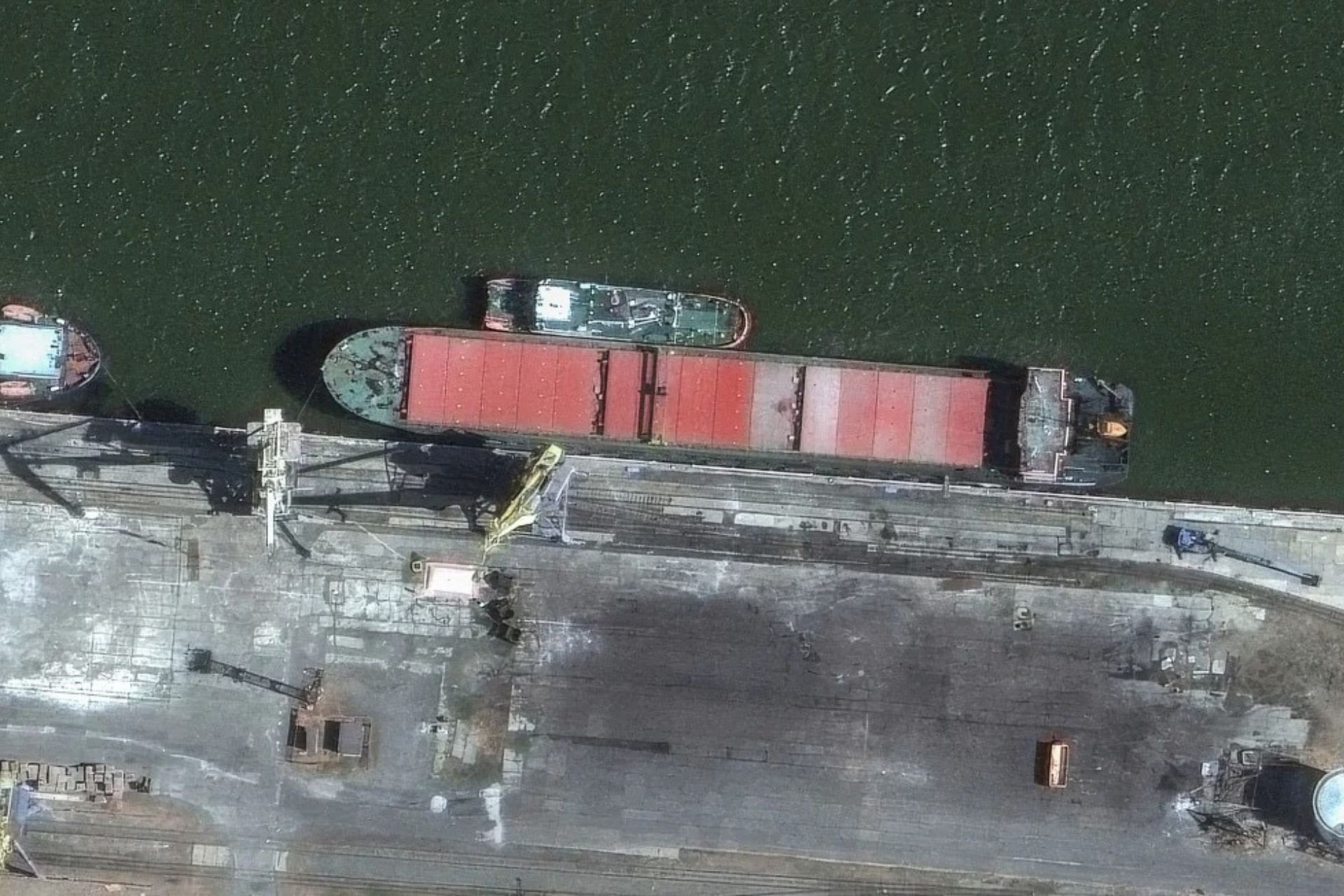Breaking News
Russian Cargo Ship Spotted Transporting Iranian Missiles for Ukraine Conflict.
On September 11, 2024, SkyNews published satellite images revealing the presence of a Russian cargo ship suspected of transporting ballistic missiles from Iran. This transfer marks a strengthening of military cooperation between Moscow and Tehran. The development was confirmed by the United States and several European allies, representing a new phase of Iran’s involvement in the war in Ukraine. The ship, identified as the Port Olya-3, reportedly transported short-range ballistic missiles, specifically Fath-360s, which are expected to be used against Ukraine in the coming weeks.
Follow Army Recognition on Google News at this link

A satellite image shows the Port Olya 3 vessel at Port Olya in southern Russia on 4 September 2024 (Picture source: Maxar)
The Port Olya-3, a vessel under the Russian flag, was spotted on September 4 in a port in the Astrakhan region of Russia after leaving Iran’s Amirabad port six days earlier on August 29. Data from ship tracking and images captured by Maxar Technologies clearly show the ship’s route across the Caspian Sea. This ship regularly transports cargo between Iran and Russia, and this time, it is believed to have carried 225 ballistic missiles, according to Ukrainian sources cited by Sky News.
These Fath-360 missiles are short-range weapons equipped with satellite guidance technology. They have a maximum range of 120 kilometers and can carry a 150-kg warhead. Designed for high-precision strikes, these missiles pose a significant threat to Ukraine’s military and civilian infrastructure. Their delivery to Russia, combined with the training of Russian military personnel in Iran on their use, signals a significant escalation in the Ukraine conflict.
The Fath-360 was developed as part of Iran’s military modernization program. The missile has demonstrated its ability to strike distant targets with precision, largely due to its advanced guidance system. Its 150-kg warhead makes it a formidable weapon, capable of destroying fortified positions or strategic infrastructure. Although the exact number of missiles delivered to Moscow is unclear, agreements signed between Russia and Iran in late 2023 suggest that hundreds of these missiles could be in circulation.
Iran’s involvement in the Ukraine war is not new. In addition to these ballistic missiles, Tehran has supplied Russia with kamikaze drones used in targeted attacks on Ukrainian infrastructure. This military support fits within a broader framework of cooperation between Moscow and Tehran, as both countries face increasing international sanctions. In search of reinforcements to sustain its war effort, Russia is increasingly relying on partners such as Iran and North Korea, the latter having recently delivered ballistic missiles and ammunition to Moscow.

Marine tracking data from MarineTraffic reveals the ship's prior voyages. (Picture source: GoogleMaps)
The military relationship between Russia and Iran is not limited to missile transfers. In recent years, the two countries have deepened their cooperation in various areas, including arms transfers, joint exercises, and military technology exchanges. Tehran has expressed interest in acquiring Russian Su-35 fighter jets and S-400 air defense systems, though Moscow has not yet fulfilled these requests. If these systems were to appear in Iran, it would further reinforce the notion that the ballistic missile transfer has granted Tehran some degree of leverage over Moscow.
However, Russia is in a delicate position. If it transfers highly advanced weapons to Iran, it risks deteriorating its relations with regional powers such as Saudi Arabia and the United Arab Emirates, who could then turn to the United States or Israel to counterbalance the Russo-Iranian alliance. Saudi Arabia, in particular, plays a crucial role in the OPEC+ framework, an alliance that helps maintain relatively high oil prices. A breakdown in this cooperation could lead Saudi Arabia to increase oil production, resulting in lower prices that would negatively impact both Russia and Iran, who already sell their oil at reduced prices due to Western sanctions.
The announcement of this missile delivery has triggered a wave of international reactions. The United States, along with the United Kingdom, France, and Germany, immediately imposed new sanctions on Iran. U.S. Secretary of State Antony Blinken, during a visit to London, emphasized that these deliveries represented a dangerous escalation, calling for a strong response from the international community. European governments expressed similar concerns, describing this military cooperation as a "direct escalation" and underscoring that it poses a threat to European security.

Although the exact number of Fath-360 delivered to Moscow is unclear, agreements signed between Russia and Iran in late 2023 suggest that hundreds of these missiles could be in circulation. (Picture source: Wikimedia)
The growing role of Iran in supplying weapons to Russia raises several questions. On the one hand, it underscores Moscow’s increasing dependence on foreign partners to sustain its war effort in Ukraine, signaling a gradual weakening of its internal capabilities. On the other hand, it strengthens Tehran’s position on the international stage, allowing it to exercise growing influence over Russia while avoiding direct involvement in the conflict. This strategy aligns with Iran’s typical approach of acting through proxies, using other forces to fight its enemies while preserving its own resources.
Finally, the missile deliveries from Iran to Russia are part of a broader context of rising geopolitical tensions. Russia, increasingly isolated by Western sanctions, is turning to more marginal partners to maintain its war effort, while Iran is leveraging this relationship to strengthen its influence in the region. The response from the United States and its allies, particularly through sanctions, highlights the seriousness of the situation and the importance of the issues at stake.
In the coming weeks, the international community will closely monitor Russia’s use of these ballistic missiles and the evolution of its military cooperation with Iran. The consequences of these arms transfers could significantly influence the outcome of the war in Ukraine while reshaping alliances and power dynamics in the region.


























